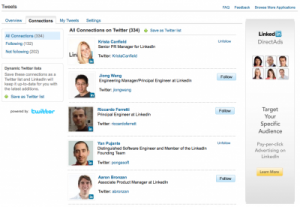I’m sure this isn’t much news to many people in the recruiting community, but this article is for job seekers.
1. You can’t get fired for creating a LinkedIn Profile.
You wouldn‚Äôt upload your resume on Monster and then send an email to your boss and co-workers saying ‚ÄúI just put my resume on Monster‚Ķcome take a look!‚Äù That would be job suicide. On LinkedIn, it’s different. LinkedIn is a smart professional decision. Uploading your ‚Äúresume‚Äù on Monster, means you‚Äôre looking for a new job. Creating a LinkedIn ‚Äúprofile‚Äù shows that you understand the importance of building professional relationships and that you are up to speed on Professional Networking online.
2. LinkedIn is Free for Job Seekers and Recruiters.
Monster charges $9,000 per company employee, per year, for access to YOUR resume! In fact, Monster makes something like $1 Billion annually from selling your resume to employers. LinkedIn does it for free! LinkedIn does have many paid upgrade options, but these are only optional and they are not required to get most of the functionality.
3. Recruiters are flocking to Linkedin and canceling their Monster accounts.
With millions of people unemployed, employers are getting hundreds of applicants for every job posting. Finding candidates isn’t a problem, like it used to be. As a result, fewer companies are buying resume database licenses. With tighter budgets, recruiters are being forced to use alternatives, like LinkedIn, that are free. When the economy starts turning around, employers and staffing firms are going to continue to use the most effective and least expensive tools to find candidates. LinkedIn will only get better.
4. LinkedIn is a virtual “Corporate Employee Directory”.
The LinkedIn, “Company Search Feature” allows job seekers to view loads of great information about thousands of companies. A search could reveal your 1st degree and 2nd degree contacts who are current or past employees, employees that share similar groups, like professional trade groups, and alumni organizations. LinkedIn boasts employees from all of the Fortune 100 companies, a statement that Monster can‚Äôt make.
As a job seeker, if you’re trying to connect with employees in the company, to find a possible employee referral, a simple LinkedIn company search might just do it. While LinkedIn doesn’t provide direct contact information, if you are a savvy LinkedIn user, you can definitely find ways to connect and contact just about anyone on LinkedIn.
I’m releasing an online training series Referrals Get Hired!, that teaches job seekers how to find and connect with employees and ask for referrals. If you are interested in getting notified of when I release the training, put your name and email in the box to the right.
5. LinkedIn is the largest and most active online community of human resources, staffing and recruiting professionals.
LinkedIn claims over 500,000 recruiting and HR members. From my estimates, that means that LinkedIn has 10 times more staffing and recruiting members actively engaging candidates than paying members of both the Monster and CareerBuilder resume databases, combined!
As a job seeker, if you want to research, or find, or contact a recruiter, there is no better place, they’re all on LinkedIn. They’re easy to find – do an “Advanced People Search”, with the word “recruiter” in the “title” field. You can even filter the results by your local region, and industry.
Recruiters are also very active in LinkedIn groups. So join some industry trade groups, as well as any of the large “job” and “career” oriented groups, and connect with them.
6. Recruiters are sourcing more and more candidates from LinkedIn.
Everyday I talk to another recruiter, or see another testimonial, where an executive recruiter says they are finding and placing more candidates from LinkedIn than any other source. This is good to know, but it must be stated that these are “executive recruiters” hiring senior managers and executives. LinkedIn isn’t yet the “go to” resource for all types of positions. In the next couple of years, we’ll see this continue to move out of the executive ranks and into operations and line management positions, as LinkedIn membership grows beyond its primary “professional” demographics.
7. LinkedIn has already become a defacto “social reference check”.
Over 45% of employers have already stated they are using LinkedIn to run background checks on applicants (2009 CareerBuilder study), and another 35% say they will be doing so this year (CareerXRoads, 2009 Source of Hire Study). Recruiters never used Monster for this because Monster is only one dimensional, meaning recruiters could only read what a user uploaded, their resume. Profiles on LinkedIn are multifaceted, including recommendations, links to blogs, twitter applications, providing recruiters with many more ways of researching candidates. In addition, LinkedIn is constantly being updated with new information in Groups, Questions and Answers, etc. whereas, Monster is very static.
If you are looking for a job, it’s critical that your LinkedIn Profile matches what is on your resume, and vice versa. Recruiters are using the information they find and comparing it to your resume. If there are holes, or your resume doesn’t match, or other questionable issues come up, employers might us the information they find to disqualify you. If you‚Äôre not listed, or your profile isn‚Äôt complete, or doesn’t match your resume, you‚Äôre out of luck.
8. LinkedIn Search Engine Optimizes your profile for you.
When your profile is complete, LinkedIn lists your profile in it’s public directory, which makes it easy for Google to index and list your profile in their search results. Monster; however, locks down your resume and charges recruiters to view YOUR resume. If an employer doesn‚Äôt want to pay‚Ķ you are the one that loses. LinkedIn helps market you, because it’s good for them. LinkedIn knows that recruiters are not just searching Linkedin.com for candidates. Many recruiters search Google as well.
Tip: Have you ever typed in your name into Google and found your LinkedIn profile? That’s because LinkedIn is trying to make its content, profiles, available for the public.  They do a great job of it.
9. LinkedIn isn’t just for posting a profile and looking for jobs, it‚Äôs a professional community.
Monster’s singular purpose is to help employers and job seekers find each other. That’s fine, but if you’re not looking to find a new job, there is no reason to go to Monster. LinkedIn, however has over 60 Million members, many of whom are actively involved in some of the largest and most active professional, trade, and alumni groups on the web. As more and more users come on board, LinkedIn only gets better. It’s a community, based on community built content.
10. Employers would rather hire “Passive” candidates.
While this isn’t news, it’s a strategic difference between Monster and LinkedIn. Monster is considered a great place to find ‘active’ candidates. Whereas LinkedIn, because of its community basis, is a great place to find passive candidates. Again, uploading a ‚Äúresume‚Äù on Monster, by definition, means you are an ‚Äúactive‚Äù candidate.
The purpose of this blog post was to help define why LinkedIn is so vital to a job seeker. I truly believe that LinkedIn is now more important than Monster, for a lot of reasons. That doesn’t mean that job seekers shouldn’t use Monster or any other job board, including GOJobs.com, the job board that I own. They should, because job boards have loads of job postings, employers use them everyday, and as a job seeker, you need to use any and every tool that can help you find a job.



